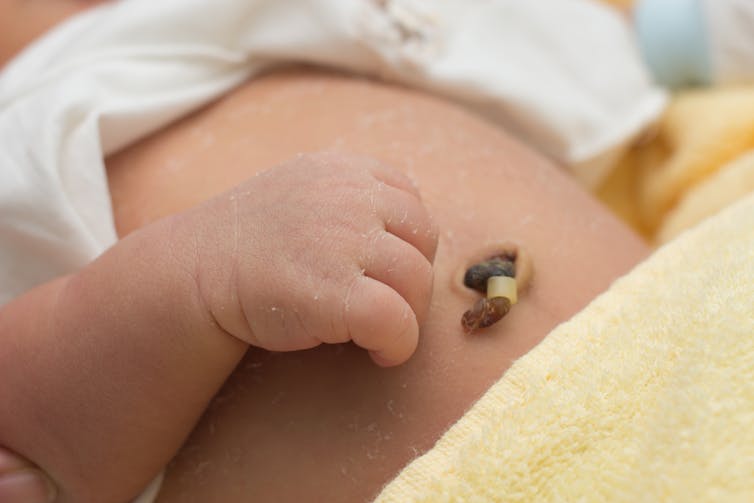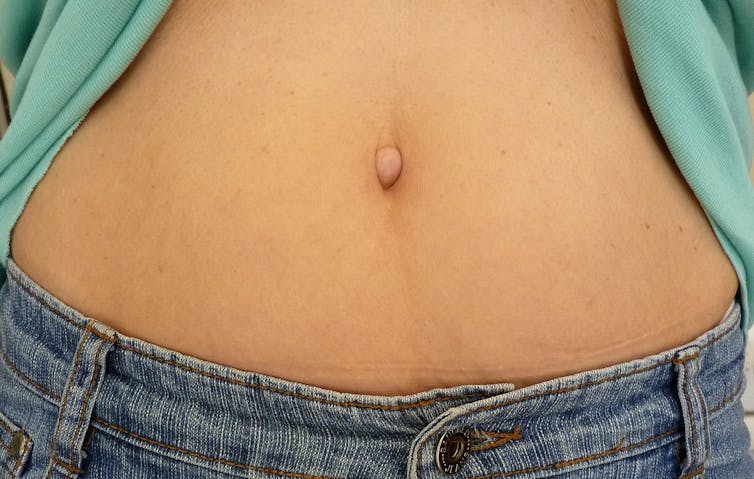Innies, outies and omphalophobia: 7 navel-gazing questions about belly buttons answered
Everyone has one, but you might not know much about it. Here biologist Sarah Leupen, who teaches human and comparative animal physiology, explains the ins and outs of belly buttons.
1. Why do I even have a belly button?
Your belly button, or navel – clinically, your umbilicus – is the permanent scar left from where your umbilical cord connected your circulatory system, when you were a fetus, to the placenta. Fetuses don’t breathe, eat or eliminate waste, so the placenta provides an exchange site for the mother to deliver oxygen and nutrients from her bloodstream to the fetus, as well as collecting its wastes to eliminate from her body.

Wacharaphong/iStock via Getty Images Plus
After the baby is born, the physician or other attendant cuts the cord and clamps off the stub, which then dries and falls off after about a week, leaving the point of connection – your belly button – remaining.
If the cord is not cut, as has been the practice in some times and places and as is becoming trendy again in others, it will close off after an hour or so, then naturally detach a few days after birth. Some health care practitioners are concerned that this “lotus birth” could be an infection risk, since the umbilical cord remains attached to the placenta, which is dead tissue once out of the mother’s body.
2. If it’s a scar, why doesn’t it disappear over time?
If you injure just the outer layers of your skin, as in a cut or burn, the scar will soon completely disappear, especially in young people. And newborns are very young people. But unlike in those situations, the umbilicus involves more tissue layers — not just the skin but the connective tissue underneath – so it makes sense it doesn’t just blend in with the rest of your abdominal wall once it’s healed.
What about some pretty complicated surgeries that don’t leave scars? Doctors perform many operations in ways that deliberately avoid scarring, which is not nature’s way. In fact, one way to minimize scarring for surgeries uses this existing scar – surgeons can take advantage of the navel as an incision site for removing your appendix or gall bladder or for weight-loss surgery.
But if you don’t like the way your umbilical scar looks, plastic surgery to change its appearance, called umbilicoplasty, is possible. People sometimes take this cosmetic option after pregnancy or the removal of a piercing, or just to make an “outie” into an “innie.”

Zeev Barkan/Flickr, CC BY
3. But why do some people have outies, anyway?
The look of your belly button is not related to the location of the clamp or where your doctor cut the cord.
Outies are simply an example of normal human variation, like the way some people have curly hair or dimples. When the tip of the umbilical cord’s remnant pokes out past the skin around it, you have an outie; about 10% of people have these. Any concave navel is called an “innie” and a convex one an “outie.”
Sometimes outies can be caused by an umbilical hernia in the baby or another medical problem, but most of it is just due to what your genes encoded. You might also temporarily have an outie during late pregnancy, when the abdominal pressure from the growing fetus stretches your navel and may push it out.
4. How deep does it go?
You can probably easily probe the depth of your own navel – there are no hidden recesses there. What’s under it is the same as what’s under the skin of the rest of your abdomen: your abdominal muscles, to which the navel is attached by a short umbilical stalk, and the peritoneum, the membrane that lines the abdominal cavity. Under that lie your guts – that is, your intestines and other abdominal organs. If you keep following this imaginary journey back, you’ll get to your spine – the belly button is usually lined up between the third and fourth lumbar vertebrae (L3 and L4).
5. Do other animals have belly buttons?
Because the navel is a scar from where the umbilical cord connected the fetus to the placenta, all placental mammals have them. That includes all mammals except marsupials (like kangaroos and possums) and monotremes (like platypuses and echidnas).
Your cat or dog or guinea pig does have a belly button, but because it’s a flatter scar than a person’s rather than a concave one, and is covered in fur, you might have missed it.
6. Is there anything besides lint in there?
Like any concave surface, if you have an innie, it probably gathers bits of debris occasionally. Your navel also has microbiota, just like the rest of your skin. Because it’s pretty protected from soap and abrasion, a more stable and diverse bacterial community lives in your navel than elsewhere on your skin’s surface.
The innovative Belly Button Biodiversity project at North Carolina State University has revealed a lot about these little friends. The researchers found over 2,000 species of bacteria in the first 60 belly buttons they investigated.
It looks like most people have a set of eight common belly button bacteria, but the project is discovering new ones all the time.
7. Why do belly buttons gross out some people?
There hasn’t really been much research into why some people find belly buttons to be repulsive.
It may overlap with omphalophobia, the fear of belly buttons and touching them. There’s no specific treatment beyond the therapy or anti-anxiety medications a doctor might prescribe for any other phobia.
Whatever your feelings about belly buttons, they’re harmless. What’s more, they’re part of your evolutionary legacy as a mammal, the group of animals so invested in their offspring that they invented a way to deliver nutrients and oxygen, the mother’s bread and breath, straight into their developing young. Your navel can be a reminder of that first life-sustaining care you received from another person before you were even born.
Stay connected with us on social media platform for instant update click here to join our Twitter, & Facebook We are now on Telegram. Click here to join our channel (@TechiUpdate) and stay updated with the latest Technology headlines. For all the latest Technology News Click Here
